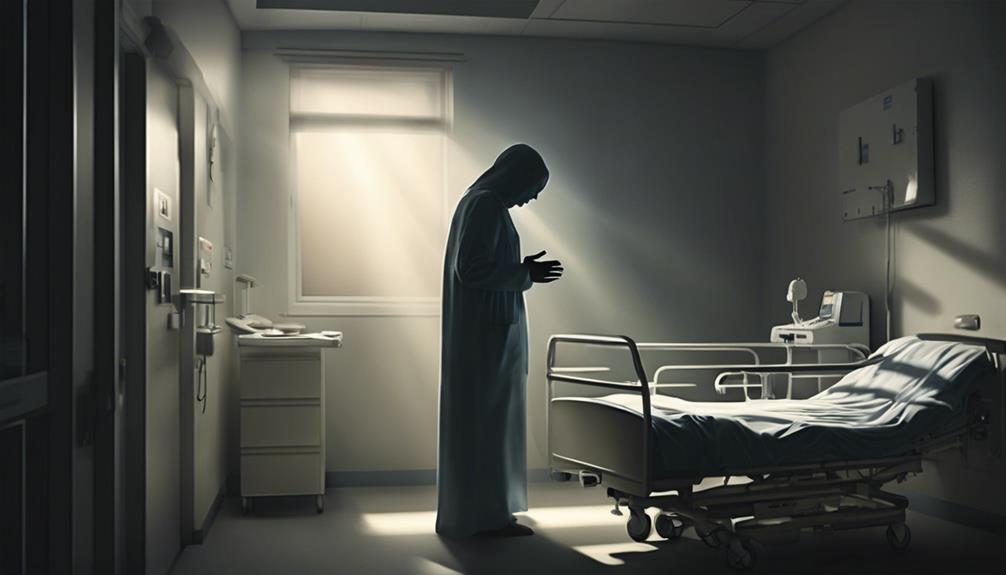Hallucinations near death typically start subtly a few months before passing, intensifying as the end approaches. Factors like lack of oxygen and stress can trigger them. Individuals may see deceased loved ones or angels. Recognizing the timing of these experiences is crucial for proper care. The hallucinations become more pronounced towards the end, sometimes accompanied by physical changes. It is essential to manage symptoms and provide comfort. Recognizing and addressing these visions is vital for offering appropriate support. Being prepared to offer comfort is a necessity. Acknowledging and addressing these experiences is crucial. Understanding more about hallucinations near death can assist in providing comfort and support.
Key Takeaways
- Hallucinations near death can start subtly a few months before passing.
- Onset of hallucinations typically occurs gradually as death approaches.
- Factors like lack of oxygen and stress can trigger hallucinations.
- Sensory experiences, including hallucinations, increase in frequency as death nears.
- Recognizing and accepting hallucinations is crucial for providing support and comfort.
Timing of Hallucinations Near Death
As we approach the topic of the timing of hallucinations near death, it becomes evident that these experiences can initiate several months before the individual's passing. For those who are dying, hallucinations can be a part of their journey towards death. The timing of these hallucinations is essential in providing the right care and support. As death nears, the frequency of hallucinations tends to increase, becoming more common in the final weeks and days leading up to the individual's passing. Understanding this timing is important for caregivers and loved ones in offering comfort and assistance to those experiencing these visions.
Care during this time is important, as early stage hallucinations can actually be comforting and reassuring for the individual. Creating a calm and safe environment can help manage these experiences. By recognizing the timing of hallucinations near death, caregivers can adapt their approach to better support the individual in their final days. It's a time where compassion and understanding play a significant role in providing comfort and care.
Onset of End-of-Life Hallucinations

The onset of end-of-life hallucinations typically marks a few months before the individual's passing, gradually increasing in frequency as the time of death draws near. These hallucinations are often accompanied by physical changes, such as periods of no breathing, and can manifest as auditory hallucinations or visual experiences. Signs of Approaching death, like these hallucinations, can be distressing for both the person experiencing them and their loved ones.
Managing Physical symptoms and providing comfort during this time is critical. It's important to make sure the individual is as comfortable as possible and that their surroundings are conducive to a peaceful atmosphere. Connecting with others for support and seeking professional help if needed can help navigate this challenging period. Understanding that these hallucinations are a common occurrence before death can help alleviate fear and uncertainty. By acknowledging and addressing these experiences with compassion and care, we can help those nearing the end of life feel supported and comforted. Creating a safe and soothing environment, tailored to the individual’s needs, can significantly improve their sense of well-being during this sensitive time. For those experiencing symptoms of Lewy body dementia, it is especially important to approach their care with patience and understanding, as these symptoms can include hallucinations, confusion, and fluctuations in cognitive function. By fostering an atmosphere of empathy and providing consistent reassurance, we can help diminish feelings of distress and promote a sense of peace.
Hallucination Occurrence Before Death
As we explore hallucination occurrence before death, it's important to understand the timing, types, and causes of these experiences.
Hallucinations typically begin a few months prior to passing and can intensify as the end nears. Factors like lack of oxygen, medications, stress, and the presence of deceased loved ones can trigger these visions.
Timing of Hallucinations
Near death, individuals may start experiencing hallucinations a few months before their passing. As death approaches, the frequency of these hallucinations tends to increase, providing both challenges and opportunities for support and comfort.
Recognizing the timing of hallucinations can help caregivers and loved ones understand and navigate this delicate period with empathy and care. By staying informed about the progression of hallucinations, one can offer the necessary assistance and reassurance to those experiencing these phenomena.
It's essential to approach these hallucinations with understanding and patience, providing a sense of security and calmness during this time. Being aware of when hallucinations are likely to occur can aid in preparing for and responding to these experiences effectively.
Types of Hallucinations
During the period before death, individuals may experience a variety of hallucinations involving visions of deceased loved ones, angels, Jesus, or spirit-like beings. These visions can provide comfort and reassurance to those nearing the end of life. Seeing deceased loved ones or angels is a common occurrence as the brain processes the approaching shift.
It's essential to offer support and understanding to individuals experiencing these hallucinations, as they play a significant role in the end-of-life process. By acknowledging and validating these visions, we can help ease the journey for our loved ones as they approach the end of life. Understanding the types of hallucinations that may occur can better prepare us to provide the necessary support and compassion during this challenging time.
Causes of Hallucinations
Hallucinations occurring before death may stem from a variety of factors, including the impact of oxygen deprivation on the temporal lobe and the deterioration of brain cells. These causes can trigger vivid experiences that may be distressing for individuals nearing the end of their life. Understanding the reasons behind these hallucinations is essential for providing compassionate care and support during this challenging time.
Ways to support individuals experiencing hallucinations near death include:
- Providing a calm and comforting environment
- Offering reassurance and validation of their experiences
- Ensuring proper pain management and medication adjustments
- Encouraging open communication with healthcare providers
- Implementing relaxation techniques and mindfulness practices
Hallucination Start: Nearing Death

As individuals approach the end of life, the onset of hallucinations becomes more pronounced, typically beginning a few months before their passing. These hallucinations, often comforting, may involve seeing deceased loved ones or spiritual beings. As death draws nearer, the frequency of these experiences tends to increase, especially in the final stages. These visions can vary in form, from visual to auditory or sensory encounters.
Understanding when hallucinations near death start is essential for supporting those going through this process and their families. By knowing that these hallucinations commonly begin a few months before death, individuals can prepare emotionally and spiritually for what may come. Embracing the idea that these visions can bring comfort and solace, especially when they involve familiar faces or spiritual guides, may help ease the fear or uncertainty that can accompany the end of life journey.
Being aware of the timing and nature of these hallucinations can provide a sense of reassurance and understanding for all involved, fostering a more supportive and compassionate environment during this challenging time.
When Hallucinations Begin Near Death

Near the end of life, individuals may begin to experience vivid visions and encounters that provide comfort and solace. As these hallucinations start near death, it's important to understand the timing, frequency, and intensity of these experiences to provide proper support. Here are five significant points to keep in mind:
- Early Signs: Hallucinations near death can start subtly, appearing a few months before passing, and gradually increasing in frequency.
- Variability: The onset of hallucinations close to death is common, but the intensity and duration can vary greatly from person to person.
- Intensification: Visions and hallucinations may become more frequent and intense in the final weeks leading up to death, requiring increased support and understanding.
- Preparation: Understanding when these hallucinations begin can help prepare caregivers and loved ones to offer the necessary support and comfort.
- Support: Providing comfort, reassurance, and a non-judgmental presence during the start of hallucinations is essential in helping the individual navigate this aspect of the dying process effectively.
Hallucinations Timeline in Dying Process

As we explore the timeline of hallucinations in the dying process, we'll focus on the onset of visual hallucinations, auditory hallucinations patterns, and the frequency of sensory experiences.
These points will help us understand when these phenomena may occur and how they can evolve as someone nears the end of their life.
Onset of Visual Hallucinations
During the progression towards death, the onset of visual hallucinations becomes more pronounced and frequent as individuals near the end of life.
- Visual hallucinations near death can start as early as a few months before passing.
- The onset of visual hallucinations tends to increase in frequency as death approaches.
- Individuals may experience visual hallucinations more intensely in the final weeks of life.
- Visual hallucinations near death can be comforting or distressing, depending on the individual and their experiences.
- Understanding the timeline of visual hallucinations can help prepare for and support loved ones through the dying process.
Auditory Hallucinations Patterns
Exploring auditory hallucination patterns in the dying process sheds light on the evolving sensory experiences individuals encounter as they approach the end of life. Auditory hallucinations, such as hearing voices or sounds that aren't present in reality, typically begin a few months before death. As the end nears, these hallucinations may increase in frequency and intensity.
This emphasizes that these auditory hallucinations can vary in nature, being either comforting or distressing for the individual. Providing support, reassurance, and understanding to those experiencing these hallucinations is vital in helping them navigate this challenging time. By acknowledging and addressing these auditory hallucinations with care and compassion, we can contribute to the comfort and well-being of individuals in the dying process.
Frequency of Sensory Experiences
Understanding the progression of sensory experiences, particularly hallucinations, in the dying process is essential for providing appropriate support and care to individuals nearing the end of life. As individuals approach their final days or hours, the frequency of sensory experiences, such as hallucinations, tends to increase. In the midst of a terminal illness, these individuals may experience hallucinations more intensely and frequently. It's vital to be prepared for this aspect of the dying experience and offer comfort and reassurance during these challenging moments. By acknowledging and addressing the frequency of sensory experiences, we can better support those going through this difficult time.
Compassion and empathy go a long way in providing comfort.
Offering a listening ear can help ease the distress caused by hallucinations.
Creating a peaceful environment can promote a sense of calm and security.
Holding a person's hand can convey warmth and support.
Remembering that small gestures of kindness can make a significant difference.
Recognizing Hallucinations Near Death

Hallucinations near death can be recognized by the increasing frequency of vivid visions experienced by individuals as their passing approaches. These hallucinations often involve seeing deceased loved ones, angels, Jesus, or spirit-like beings. It's important to understand that these visions may start a few months before death and become more frequent as the end nears.
Recognizing these hallucinations is vital for providing appropriate support and comfort to the individual going through this experience. As loved ones, our role in acknowledging and accepting these hallucinations can greatly impact the well-being of the person nearing the end of their life. By staying present, listening empathetically, and validating their experiences, we can help ease their fears and uncertainties during this challenging time.
Supporting our loved ones through these hallucinations near death is an act of compassion and understanding that can bring solace and peace to both the individual and those around them.
Frequently Asked Questions
Why Do People Hallucinate Before Their Death?
We hallucinate before death due to various factors like lack of oxygen, dying brain cells, medications, stress, and loved ones' spiritual connections. These visions can comfort and prepare us for the change, offering solace in the face of mortality.
How Long Does End-Of-Life Stage Last?
The end-of-life stage's duration varies, with some experiencing it for weeks. Understanding these stages helps us support those nearing death. We can provide comfort and reassurance, vital aspects in this profound journey.
What Is the Surge Before Death Called?
The surge before death is known as the 'surge of energy.' It can bring increased alertness and strength to the individual. We must be prepared for potential changes during this time, offering appropriate support and care.
How Long Does End-Of-Life Confusion Last?
End-of-life confusion can vary in duration, influenced by health and circumstances. It may intensify as the body shuts down. Factors like medical conditions and medications play a role. Comfort and reassurance help ease this experience.
Conclusion
As we near the end of life, hallucinations may start to appear, signaling a passage into the unknown. Just as shadows lengthen before dusk, these visions may be a natural part of the journey towards the final sunset.
Embrace the mysteries that come with this time, and remember that these experiences can offer a glimpse into the wonders that await beyond the horizon.









